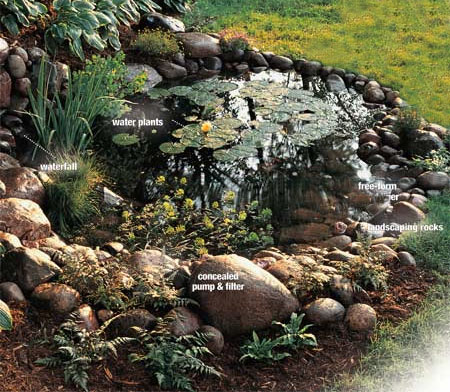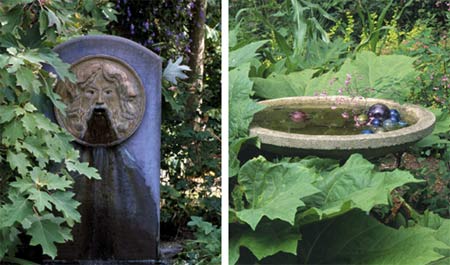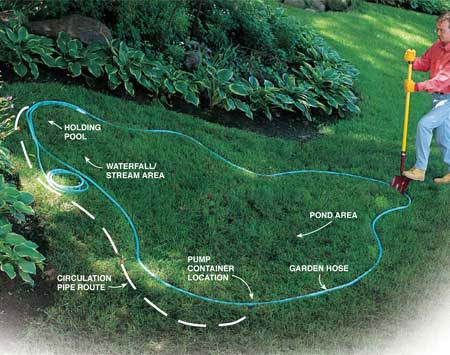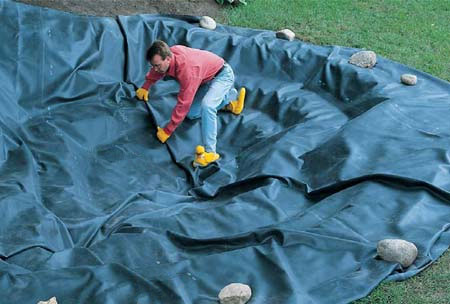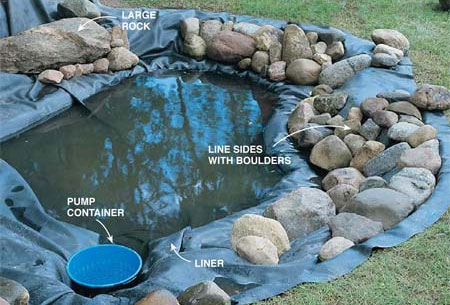Simple Ways to Add Water to a Garden
Enjoy the benefits of a water feature in your garden without spending a lot of time or money
04/04/2023
See below for instructions on building a small pond.
I once thought having a water feature in my garden would require a major investment of time and money, as well as a lot of space. I was wrong. When I finally added a small pool to my suburban garden, I opened the door to an enchanting world that delighted my senses and enriched the garden’s design.
Like a mirror, the glassy surface of a still pool reflects the blue sky and shifting patterns of clouds. Water ripples with the slightest breeze and sparkles in sunlight. The sound of moving water is always soothing; it is especially refreshing on a hot day.
No garden is too small for water. You don’t need to install a pond; any water-tight vessel can be transformed into a water garden.
Appealing options include kettles, urns, glazed pots, and stone troughs. Millstones make attractive fountains, and there are many distinctive carved-stone and concrete fountains and basins, available from art galleries, specialty garden shops, architectural salvage centres, and even your local Builders Warehouse.
Water also creates opportunities for a new kind of gardening with a specific group of plants - aquatics. Even the smallest container can be filled with decorative water plants. In larger basins or ponds, add drama with colourful tropical plants like elephant ears (Colocasia esculenta), swamp lilies (Crinum spp.), and cannas (Canna spp.), as well as traditional water plants such as irises, water lilies, spike rushes (Equisetum spp.), and hardy canna (Thalia dealbata).
Another benefit of water gardening is that wildlife flocks to water like obsessed gardeners to a rare-plant sale. Dragonflies dart through the garden on gossamer wings, and frogs lull you to sleep with their curious serenade.
Use your water feature as a focal point in a garden bed, or at the end of a vista. Place a basin where you can view it from a window, surrounded with contrasting plant forms. Try a simple reservoir of still water or add a bubbler for sound and motion. I added a small pump to my pool to mitigate the roar of traffic along the busy street that bordered my former garden.
You can also go for a well instead, which can provide a sustainable water source for your plants. It’s a great source of calcium and magnesium, essential nutrients for them to survive.
Depending on the well type and design, it can also make your garden more aesthetically appealing. As such, it can be considered a significant investment that helps boost your property’s value.
However, a garden well is also susceptible to damage, especially if it’s not maintained properly. So look for a local professional who can provide the best well repair in case you’re seeing any signs of damage. A well is only one of the many water features you can add to your garden. If you’re looking for alternatives, a pond is also an excellent choice. Here’s how to build a garden pond.
Build a small garden pond
In this project we take you through the basic steps for building a pond. There's no need for precise measurements, you can make the pond as small, or as large, as you wish.
The basic pond consists of a good-quality liner, a high-efficiency pump, and lots of stone and gravel. For a little bit more money you can add the convenience of a filtration system, which will reduce your weekly maintenance chores. Larger ponds won't cost a whole lot more; you've already made most of your investment in pumps and filters.
Step 1. Mark out the area for the pond. Before you start digging, lay on the ground the water circulation pipe that goes from the pump to the waterfall. Throw the excavated soil on top of it. This will save you the work of digging a trench to bury the pipe. Now dig out the pond bed, terracing both shallow and deeper areas for plants. Exposed rocks, tree roots and anything else that might puncture the liner must be removed from the hole.
DIY Tip
Use the excavated dirt to berm up around your pond or build up your waterfall area. It will save you the hassle of having it hauled away or running it around your yard in a wheelbarrow.
Step 2. Place the layer over the terraced area. Wear soft-soled shoes and walk on the liner only when you have to. Buy a single sheet of liner that is large enough to cover the entire pond bottom and sides - and spread the liner loosely inside the pond; don’t stretch it tight.
Liners can be spliced if necessary, but it involves more work and provides an opportunity for a leak. If your waterfall or stream requires extra length, use a separate piece of liner. You don't need to glue the two liners together as long as the stream or waterfall liner is higher than the water level of the pond.
To work out the size of liner that you need, calculate the dimensions of the liner by measuring the maximum length and the maximum width of your pond, then add three times the depth measurement to each dimension. Better a bit big than a bit small.
Step 3. Line the pond sides with rocks and set in the pump container. Wash down the rocks after they're in place and then empty the pond with your pump. For large rocks, lay a scrap piece of liner slightly smaller than the rock on top of the pond liner before positioning the rock. This helps prevent punctures.
Now you're ready to install the pump and fill you pond with water. When buying a pump you will need to advise the size of the pond so that they can calculate the necessary size pump to handle the water flow. It is also necessary to specify if the pond is going to have fish or not, as a filtration system may be necessary. It's important for water to circulate and aerate throughout the pond. Buying an inexpensive fountain head and connecting it to the end of the water circulation pipe is the easiest way to accomplish this.
A pond is just a hole filled with water. You need to add plants for it to become a water garden. Add fish and your pond comes alive. Here are a few things to keep in mind when planning for plants and fish.
- Before adding plants or fish to your newly filled pond, wait a week for the chemicals in the tap water to neutralize. To accelerate the process, you can add a dechlorinator to the water. Consult your water garden supplier for more info on this chemical.
- Anchor plants in pots or baskets designed for aquatic plants. A third option is to place the roots of each plant in “root balls, ” a mix of gravel and soil in nylon stockings tied with soldering wire. Root balls are cheaper than pots or baskets and are easier to move. They also keep fish from disturbing the soil.
- Note: Don't use standard potting soil in your pond. The high nutrient content encourages algae growth. Ordinary garden soil is just fine.
- If you plan to stock your pond with fish, part of it must be at least 30cm deep.
- Hardy fish such as goldfish don't require much attention. You don't even need to feed them once they're established, as long as your pond isn't overstocked. Hardy ones can survive by eating insects and the plant life in your pond. They actually help keep your pond clean. If you plan to stock your pond with more exotic species, you'll have to do more to ensure their survival.
fine gardening - family handyman
Conclusion
Adding water to a garden can provide several benefits. Since water is the lifeblood of all plants, you can ensure a healthy and beautiful garden in all seasons. A garden with a water feature, like a pond or a well, can also help improve the value of your home. Not only can it serve as a sustainable water source for your garden, but it can also enhance the overall aesthetic appeal of your property.

